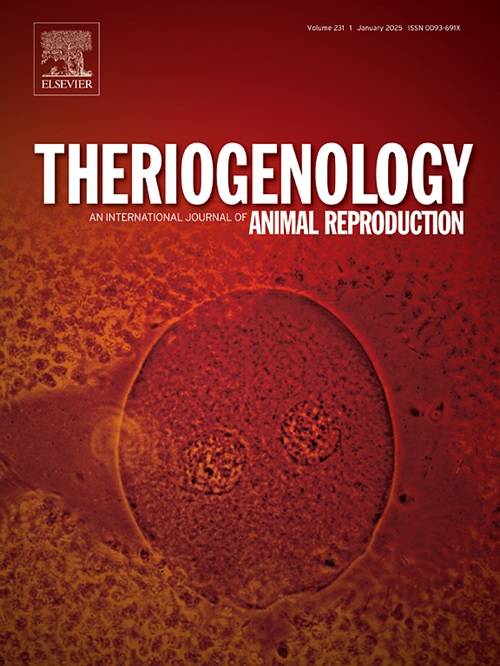Seasonal effect on farrowing duration in sows within a temporarily confined farrowing system under tropical climates
IF 2.4
2区 农林科学
Q3 REPRODUCTIVE BIOLOGY
引用次数: 0
Abstract
Global warming negatively impacts sow reproduction, leading to health and welfare challenges and economic losses in the swine industry. The present study was a retrospective observational study that examined the effects of season, temperature, and humidity during parturition on farrowing duration and piglet birth intervals in sows housed in a temporarily confined system under a tropical climate. Data from 10039 farrowings of Landrace × Yorkshire sows (January–December 2023) included parity, farrowing date, parturition onset, total number of piglets born per litter (TB), number of piglets born alive per litter (BA), percentage of stillbirths (SB) and mummified fetuses (MF), and farrowing house temperature and humidity. The temperature-humidity index (THI) and averages for the 7 days before and on the day of farrowing were also calculated. The association between these parameters and the farrowing duration of sows was analyzed. Additionally, the proportion of sows experiencing prolonged farrowing (i.e., >300 min) associated with different factors were evaluated. On average, TB, BA, SB, and MF were 13.9 ± 3.6, 12.4 ± 3.9, 5.7 %, and 5.8 %, respectively. The average farrowing duration was 228.9 ± 194.8 min, with 21.1 % of sows experiencing prolonged farrowing (≥300 min). Dystocia occurred in 5.1 % of farrowings, and the average birth interval for each piglet was 18.7 ± 26.7 min. During the 7-day period before parturition, sows were exposed to an average barn temperature of 26.7 ± 1.9 °C, with daily minimum and maximum temperatures of 25.1 ± 2.2 °C and 29.9 ± 1.0 °C, respectively. The average barn humidity during the 7-day period before parturition was 80.2 ± 5.8 %, with values ranging from 62.1 % to 90.1 %. The farrowing duration of sows was positively correlated with average temperature (r = 0.044, P < 0.001), maximum temperature (r = 0.051, P < 0.001) and minimum temperature (r = 0.057, P < 0.001) during the 7-day period before farrowing. Moreover, every 10 % increase in relative humidity during the 7-day period before parturition caused an increase in the farrowing duration of 21 min (farrowing duration = 61.0 + (2.1 × humidity), P < 0.001). Every 1 °C increase in the average temperature during the 7-day period before parturition caused an increase in the farrowing duration of 4.3 min (farrowing duration = 113.49 + (4.3 × temperature), P < 0.001). In conclusion, 21.1 % of sows in tropical climates experience prolonged farrowing durations. Elevated temperatures, humidity, and THI during the 7 days prior to farrowing or on the day of farrowing significantly extended farrowing durations and birth intervals in sows. These findings highlight the critical importance of maintaining temperature and humidity levels as close as possible to the optimal range for lactating sows (i.e., 12–22 °C), particularly in tropical regions.
求助全文
约1分钟内获得全文
求助全文
来源期刊

Theriogenology
农林科学-生殖生物学
CiteScore
5.50
自引率
14.30%
发文量
387
审稿时长
72 days
期刊介绍:
Theriogenology provides an international forum for researchers, clinicians, and industry professionals in animal reproductive biology. This acclaimed journal publishes articles on a wide range of topics in reproductive and developmental biology, of domestic mammal, avian, and aquatic species as well as wild species which are the object of veterinary care in research or conservation programs.
 求助内容:
求助内容: 应助结果提醒方式:
应助结果提醒方式:


